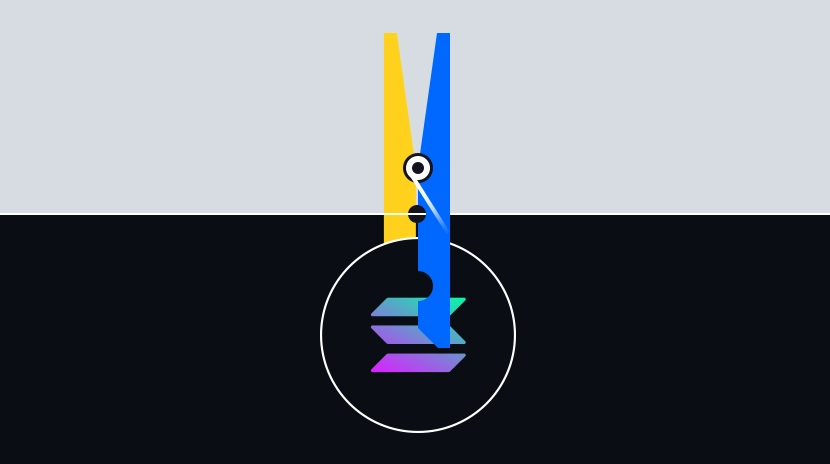¡MINT Cadena de bloques completa TGE: ¿Cuál es el siguiente paso para la innovación del ecosistema de NFT?
El 7 de marzo, Mint Blockchain anunció oficialmente la finalización de su Evento de Generación de Tokens (TGE) para su token nativo $MINT. Simultáneamente, $MINT se incluyó en varios intercambios, incluyendo Gate.com, Bitget, MEXC, BingX y BitMart.
Como miembro clave de Optimism Superchain, Mint Blockchain está trabajando activamente hacia la estandarización de activos NFT y mejorando la liquidez, con el objetivo de construir una solución líder global de capa2 para NFT.

Una red de capa 2 centrada en NFTs
Como un método efectivo para demostrar la propiedad de activos, los NFT han sido ampliamente explorados a lo largo de los años y ahora se aplican en varios campos, incluyendo juegos, arte, agentes de IA, AIGC, propiedad intelectual, venta de entradas, sistemas de membresía, sistemas de reputación, identidad digital, interacciones sociales y marketing de marca. Sin embargo, desafíos como la baja estandarización de los activos NFT, la falta de liquidez y la gestión desorganizada de los derechos de autor de los datos continúan obstaculizando el desarrollo adicional de esta tecnología emergente.
Para abordar estos problemas, los principales proveedores de servicios de datos NFT NFTScan Labs y el equipo de desarrollo de MintCore han lanzado Mint Blockchain, una red descentralizada dedicada al sector NFT. Mint Blockchain tiene como objetivo resolver estos puntos críticos y proporcionar a los desarrolladores un entorno de desarrollo más seguro, estable y eficiente.
Mint Blockchain es una red Ethereum Layer2 construida en la pila OP, con desarrollo iniciado en octubre de 2022 y su lanzamiento en la red principal en mayo de 2024. Su capa de DA (Disponibilidad de Datos) se basa en la red principal de Ethereum, garantizando seguridad a través del mecanismo de consenso de Ethereum. Dado que es completamente compatible con EVM, los desarrolladores de Ethereum pueden escalar sus proyectos fácilmente a Mint Blockchain.
Como una red de escalamiento Layer2, Cadena de bloques de MINT reduce significativamente las tarifas de gas y mejora la escalabilidad del ecosistema de Ethereum. Además, como miembro principal de la Supercadena de Optimism, Cadena de bloques de MINT es un socio estratégico de la Fundación Optimism en la región de Asia-Pacífico, trabajando juntos para impulsar el desarrollo de Supercadena y la expansión de la marca en los mercados asiáticos.
Además de su profunda colaboración con la Fundación Optimism, Mint Blockchain también ha asegurado un sólido apoyo financiero y de proyectos de instituciones de primer nivel de la industria. En mayo de 2023, Mint Blockchain anunció la finalización de una ronda de financiación inicial de $5 millones, con inversiones de Jsquare, SNZ, Antalpha Ventures, Mask Network, BlockAI Ventures, Predator Capital, Whitelist Ventures, PANONY Group y otros. Los fondos se utilizarán para la promoción global y el desarrollo de la infraestructura de NFT.
Cinco módulos principales que respaldan todo el ciclo de vida de los activos NFT
Como una red descentralizada especializada en activos NFT, Mint Blockchain se compromete a cubrir todo el ciclo de vida de los activos NFT, desde la emisión y el comercio hasta la indexación de datos en cadena. Para lograr esto, Mint Blockchain está desarrollando activamente una infraestructura de código abierto integral con cinco módulos principales:
- Estudio MINT: una herramienta especializada de creación de NFT para creadores y desarrolladores, que admite la acuñación de texto, imágenes, audio y video en NFTs en Cadena de bloques MINT, Berachain, Base, Optimism y BNB Chain.
- Capa IP: Proporciona servicios de activos de propiedad intelectual para NFT en más de 20 cadenas de bloques, incluyendo Ethereum, Cadena de bloques MINT, Solana, Berachain, Base, Optimism y Cadena BNB. Este módulo permite a los usuarios registrar y fijar precios a sus activos NFT en la cadena, lo que permite la generación de ingresos por regalías.
- Mint Liquid: Una solución de liquidez multi-cadena para el comercio de NFT y tokens, construida usando Superchain, ERC7683, Uniswap y Across Protocol. Facilita la agregación de liquidez entre cadenas y la interoperabilidad de activos.
- RWA-Rareshop: El primer mercado de NFT RWA centrado en el consumidor del mundo, que utiliza el estándar de protocolo de activos ERC7765. Admite pagos con criptomonedas, protección de la privacidad, preventas, regalos y entrega física, ofreciendo soluciones integrales de Web3 para marcas globales.
- Agente NFT-AI: Integrado con NFTScan, Mint Studio, Capa IP y Mint Liquid, este módulo proporciona reconocimiento de imágenes NFT, recuperación de datos NFT en cadena, transacciones de tokens/NFT y análisis de tendencias del mercado NFT.

A través de estas características, los nuevos proyectos Web3 pueden utilizar Mint Blockchain para emitir NFTs Genesis, POAPs NFT, SBTs y PASEs NFT, mientras que las marcas Web2 pueden aprovecharlo para la emisión de PI de NFT, la venta de entradas de NFT, las identidades digitales de NFT y los NFT de RWA. Además, Mint Blockchain proporciona a los equipos de proyectos Web3 soluciones de arranque comunitario, ofrece soluciones NFT integrales para empresas tradicionales y permite a individuos influyentes lanzar sus propios proyectos NFT de manera impecable.
Mint Blockchain tiene como objetivo convertir los NFT en los portadores de valor más sin restricciones en el mundo de las criptomonedas. Su visión es utilizar los NFT para conectar a los usuarios globales con Agentes de IA, asegurando que cada individuo en la sociedad humana, incluidos tanto humanos como Agentes de IA, pueda poseer libremente activos NFT. Para realizar esta visión, Mint Blockchain introduce un mecanismo de incentivos a nivel del modelo económico para impulsar la innovación en los protocolos de activos NFT y las aplicaciones de consumidores, con un enfoque en recompensar a los desarrolladores innovadores de protocolos de activos. Los incentivos planificados incluyen:
Ganar NFTs: Animar a los creadores a desarrollar nuevos activos NFT dentro del ecosistema Mint.
Fondo del Ecosistema MINT: Invertir y apoyar aplicaciones nativas y equipos de desarrolladores dentro del ecosistema MINT.
Recompensas de Gas ETH: Proporcionar incentivos de gas ETH para premiar los estándares de protocolo y aplicaciones sobresalientes.
Mecanismo RetroPGF: Ofrecer recompensas retrospectivas a largo plazo para los constructores de infraestructura en el ecosistema de acuñación.
El Primer Token Estándar SuperchainERC20 con Mecanismos Innovadores de Stake y Restake
El 7 de marzo, Mint Blockchain realizó oficialmente la TGE para su token nativo $MINT y lo listó en Gate.com. Como el primer token de utilidad de Superchain, $MINT adopta el estándar de token SuperchainERC20 con interoperabilidad de Optimism.
Según su tokenómica, el suministro total de $MINT es de 1 mil millones, con un 82% asignado a constructores de la comunidad, partidarios tempranos y desarrolladores del ecosistema. Específicamente: 50% para MintDAO; 20% para contribuyentes al lanzamiento; 12% para airdrops comunitarios. Otro 18% del total pertenece al equipo de MintCore.
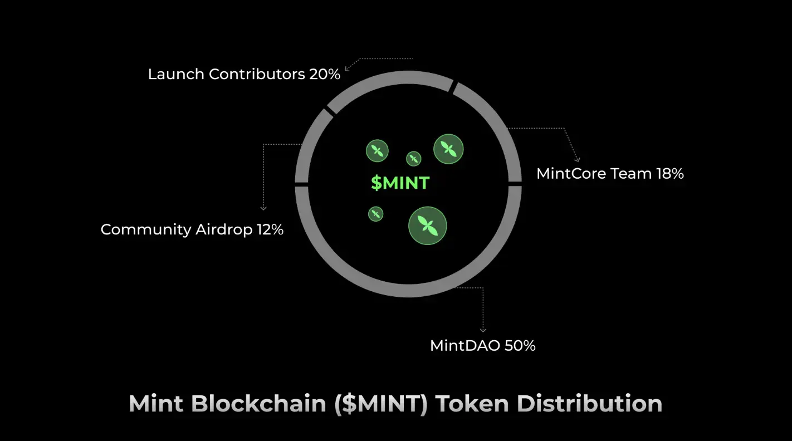
En el ecosistema de Cadena de bloques Mint, $MINT sirve como el medio coordinador de todos los flujos de valor. Su utilidad se manifiesta principalmente en gobernanza, incentivos del ecosistema, participación y uso, y fijación de precios de activos. Específicamente:
Governance & Incentives: $MINT incentiva a los desarrolladores a construir y contribuir al crecimiento del ecosistema. Los poseedores de $MINT tienen derechos de voto y pueden participar en la gobernanza de la Red Mint.
Moneda nativa y staking: Como la criptomoneda nativa de la Cadena de bloques Mint, $MINT es el activo oficial utilizado dentro de la red y sirve como el activo de staking designado para los validadores de la red.
Precios de activos y transacciones: $MINT se utiliza para fijar precios y realizar transacciones al emitir Activos del Mundo Real (RWA), NFT, tokens, memes y otros activos en la Cadena de bloques MINT.
Tras el Evento de Generación de Tokens (TGE) de $MINT, Mint Blockchain implementará un mecanismo de acuñación y reacuñación para descentralizar la distribución de recompensas por secuenciación de transacciones en la red. Esto convierte a Mint Blockchain en la primera red de Capa 2 en descentralizar la distribución de ingresos de la red.
Los usuarios pueden participar en el staking de $MINT a través del protocolo de staking descentralizado MintPool, que también admitirá el staking de activos ETH y NFT. Los participantes en el programa de staking y restaking recibirán dos capas de recompensas:
Recompensa base por participación: Un rendimiento anual del 15% en $MINT.
Recompensa por volver a apostar: el 50% de los ingresos netos de ETH generados por las tarifas del secuenciador de la Cadena de bloques de MINT.
Este mecanismo de participación y reinversión mejora la eficiencia de capital de $MINT, fortalece la seguridad de la red, estabiliza la economía del ecosistema y asegura la distribución descentralizada de recompensas de ingresos del secuenciador. Además, permite que la comunidad se beneficie del crecimiento a largo plazo de Mint Blockchain, fomentando el consenso y la participación activa en el desarrollo del ecosistema.
MintDAO: Impulsando el crecimiento de la comunidad y el ecosistema con NFT de Minty
MintDAO es la organización autónoma descentralizada (DAO) dentro del ecosistema de Cadena de bloques MINT. Como se mencionó anteriormente, MintDAO gestiona el 50% del suministro total de $MINT (500 millones de tokens) a través de una billetera multi-firma. Además, una parte de los ingresos en ETH generados por el secuenciador de red Mint, junto con los rendimientos de la inversión del Fondo del Ecosistema Mint, se asignarán al tesoro de MintDAO.
A medida que el ecosistema Mint crece, la gobernanza multi-firma de MintDAO se descentralizará progresivamente, otorgando autoridad a las organizaciones centrales del ecosistema y a los constructores para habilitar la gobernanza descentralizada.
En términos de economía del ecosistema, MintDAO es responsable de brindar apoyo temprano de liquidez para $MINT y proporcionar recompensas por participación. Para la promoción de la marca y el crecimiento de la comunidad, MintDAO impulsa la expansión comunitaria a través de MintHub, promoviendo globalmente la Cadena de bloques Mint, aumentando la visibilidad de la marca y fomentando la adopción de NFT. En cuanto al desarrollo del ecosistema, MintDAO gestiona directamente el Fondo de Ecosistema Mint, invierte en proyectos e protocolos innovadores y organiza eventos para desarrolladores en línea y fuera de línea.

Con su sólida base en la cultura de la comunidad NFT, Mint Blockchain está construyendo activamente un ecosistema impulsado por la comunidad en torno a su IP de marca, “Colección Minty NFT”. La colección se está distribuyendo a valiosos participantes de la comunidad, líderes de opinión clave de la industria NFT (KOL) y profesionales para fomentar la participación y la adopción.
Durante Token2049 en Singapur este septiembre, Mint Blockchain organizará eventos comunitarios offline centrados en la IP de Minty, distribuyendo la primera tanda de productos físicos a los asistentes. En el futuro, la comunidad planea expandirse hacia colaboraciones multi-marca, lanzando productos, eventos y emprendimientos comerciales co-brandeados. El objetivo es comercializar gradualmente la Colección Minty NFT y establecerla como un activo NFT de primera categoría.
Con el lanzamiento oficial de $MINT, Mint Blockchain está acelerando el desarrollo de la infraestructura descentralizada de NFT y promoviendo protocolos de activos NFT y aplicaciones para consumidores. A través de la innovación tecnológica, incentivos del ecosistema y participación de la comunidad, Mint Blockchain tiene como objetivo hacer que los NFT sean los portadores de valor más no restringidos en el mundo de las criptomonedas, conectando a los usuarios globales con Agentes de IA.
Mirando hacia adelante, Mint Blockchain continuará expandiendo los escenarios de aplicación, profundizando la integración de la tecnología NFT con activos del mundo real, y fomentando más innovación y oportunidades dentro del ecosistema global de NFT.
Descargo de responsabilidad:
- Este artículo se ha vuelto a publicar desde [PANews]. La propiedad de los derechos de autor pertenece al autor original [Zen de PANews]. Si hay alguna preocupación con respecto a esta publicación, por favor contacta alAprender en Gateequipo, que abordará el problema rápidamente de acuerdo con los procedimientos relevantes.
- Descargo de responsabilidad: Las opiniones expresadas en este artículo son únicamente las del autor y no constituyen asesoramiento de inversión.
- Otras versiones de idiomas de este artículo han sido traducidas por el equipo de Gate Learn. Sin mencionarGate.com, el artículo traducido no puede ser copiado, distribuido o plagiado.
Artículos relacionados
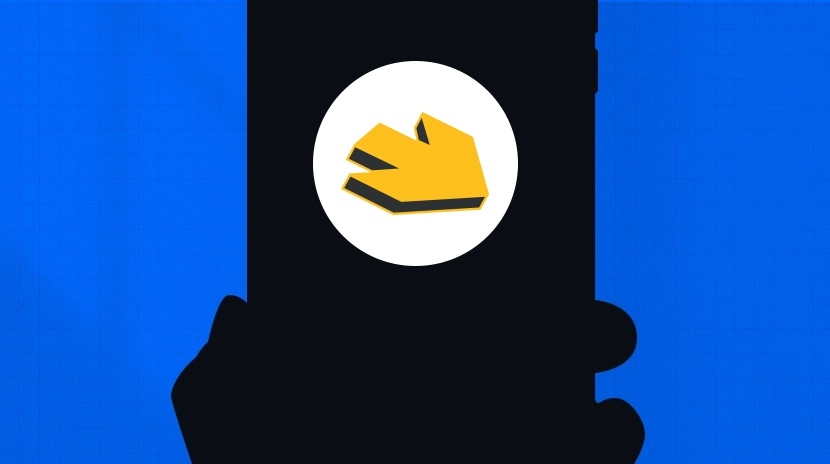
¿Qué es la Billetera HOT en Telegram?

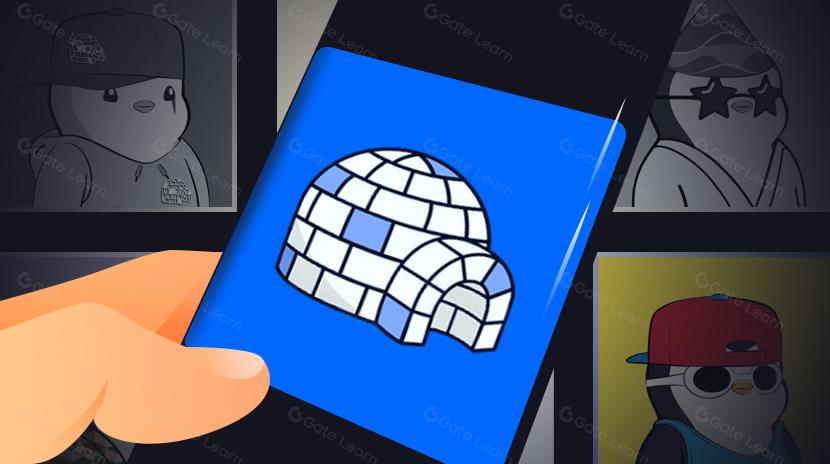
Todo lo que necesitas saber sobre Pudgy Penguins 2025

¿Qué son las narrativas cripto? Principales narrativas para 2025 (ACTUALIZADO)
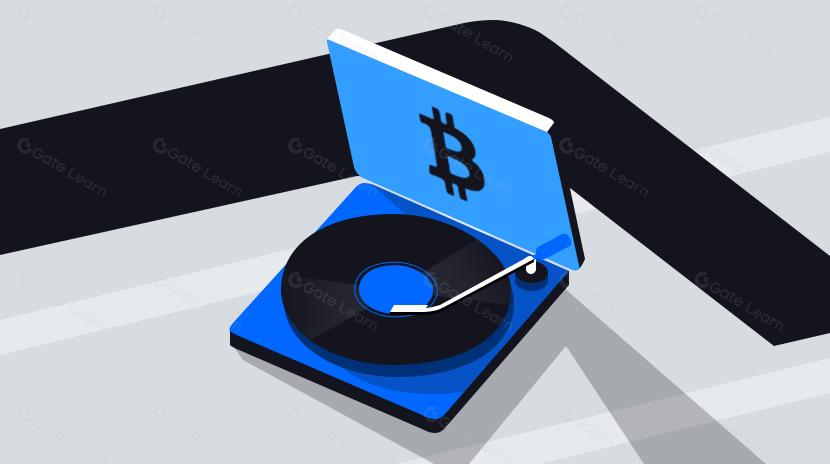
Tokenización de derechos musicales
